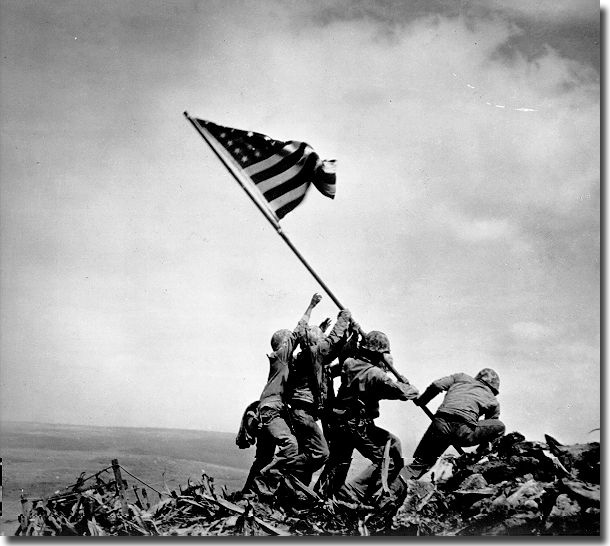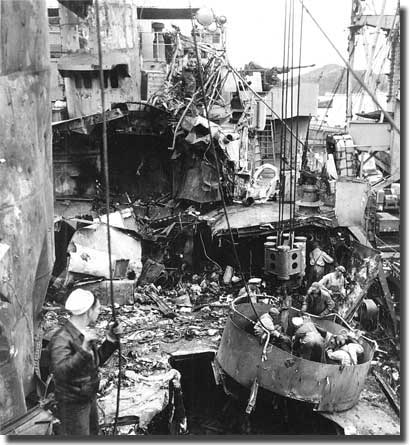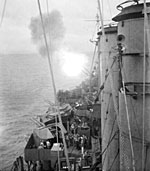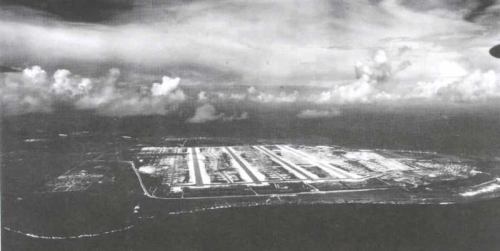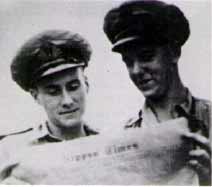|
And So To Tokyo
Introduction. Iwo Jima invasion. This invasion would be the first Japanese owned and held territory to be attacked, all other Pacific campaigns were to retake islands or areas occupied by the Japanese in their mad rush southwards in WW2. This tiny island, about 1/3 the size of Manhattan, for 36 days from the 19th. of February 1945 became the scene of one of the bloodiest and most costly battles of the Pacific war. 70,000 US Marines were involved, as 110 bombers added their bomb loads to the ever falling Naval bombardment. Lookouts in ships scanned the horizon for the approach of the dreaded Kamikaze which had made its debut at Leyte in October of 1944.Sailors skilled in radar were glued to their scopes for any sign of approaching Zombies, the nick name given to Kamikaze's by those in the Navy.Ashore, 21,000 Japanese had burrowed themselves below the volcanic rock into caves below ground. For each Marine carrying a 100 pound pack, the volcanic ash made any forward movement a nightmare, it was well nigh impossible to cope. The burdened Marines above ground were fighting an unseen enemy hidden below ground, and it took flame throwers, napalm, hand grenades to prize the Japanese out, as inch by inch the Marines battled over 36 days.
At sea, the Escort Carrier Bismark Sea was sunk after a Kamikaze attack, and the Carrier Saratoga collected a bomb, now the weather played a role, a violent storm left the cruiser San Fransisco and five destroyers damaged. Famous Photograph of Raising Old Glory on Iwo Jima.
One of the most famous photographs of WW2 in the Pacific. A Dreadful Death Toll. What a dreadful price to pay for a small volcanic outcrop stuck out in the Western Pacific. One must ask "Was this invasion really worth the paid price?" and most likely respond with " NO!" The Battle for Okinawa. Sheer enormity of the Logistics. Japanese dead. The Kamikaze Campaign.
In the following January, at the Lingayen Gulf landings, the Allied Fleet was to suffer many of these vicious attacks, over 6 weeks I saw 180 ships hit, and Australia was to have another five crash onboard her. HMAS Shropshire was the subject of attack on a number of occasions, it was a frightening experience, very sapping of morale, it became a matter of shooting down the attacking Kamikaze or collect it onboard. We despatched some 11 Japanese aircraft and shared 8 more, to fortunately remain immune from having any aircraft actually become unwelcome guests inboard.I can still vividly recall the sheer terror of seeing a Japanese aircraft diving out of the sun at the bridge of Shropshire, when I was her Officer of the Watch, diving on the deck and thinking my time had come. But the Captain of our port Pom Pom with a quick burst shot it in half, on the bridge some 60 feet above sea level I got wet from the wreck crashing alongside, I thought it was petrol, until I tasted only salt water, a very close run thing. By the time the Okinawa campaign was over, 1,485 Kamikaze flights out of Kyushu had attacked the US Fleet, sinking 30 ships, and damaging 164 others.
Huge Japanese Battleship Yamato sunk. Vice Admiral Marc Mitcher in his carrier Task Force at 1000 ( 10 AM ) on the 7th. of June, launched air strikes, and planes from USS Bennington claimed the first hits upon Yamato. Aircraft from USS San Jancito with both bombs and torpedoes accounted forthe Japanese destroyer Hamakze, the light cruiser Yahagi was stopped dead in the water through bombing. Over the next two hours, th Japanese Naval force was under constant attack, Yamato taking 12 bombs and 7 torpedoes, all this was too much, she blew up and sank. Three destroyers were too badly damaged to save, and were all scuttled, the remaining destroyers could not return to Japan. From the crew of 2.747 in Yamato, only 23 Officers and 246 sailors survive. The cruiser Yuhagi had 446 killed, Asashgi lost 330, and the other destroyers 391 men. Thus, it was a total decimation of these Japanese naval ships, with the US losses light.
The Big E collects a Kamikaze. Two major events during the Okinawa struggle. Conclusion about the Okinawa campaign. Australians at Borneo. The Japanese had taken Borneo back in 1942, it had been mostly part of the Netherlands East Indies, but the North and North West had been British territory, and the oilfields there were important, but the US submarine force had sunk most of the Japanese tankers, and choked off any oil coming from the Borneo fields to the Japanese homeland. During 1942/43 many POW'S including Australians had been sent off to Borneo, and in 1944, Australian Special troops from the Services Reconnaissance Department, Z Force were despatched to Borneo to prop up the Dyak villagers in their guerilla war against the Japanese invaders, and 2,000 Japanese died as a result of their actions.
Army Divisions. Three landings in Borneo. One of the main objectives at Tarakan was to build and repair airfields here so that air cover for the two future landings might be provided.However the boggy terrain, and the badly damaged airstrips proved more difficult than was anticipated, and thus the full utilization of these facilities was never realized. Fighter aircraft did start to provide cover at later landings from the airfields here from late June. The second landing was made at Labuan Island in Brunei Bay on the 10th. of June when the 9th. Division swarmed ashore, and they went on to lose 100 troops killed. Finally, the operation at Balikpapen in the South East of Borneo where 33,000 troops landed on the 1st. of July was to be the largest amphibious assault by Australian forces in the Pacific, and when the war came to a sudden halt on the 15th. of August, all major objectives had been achieved. A tragic footnote must be added to these Borneo operations, and that is the sad fate of many of the Australian and British POW's held at Sandakan in North Borneo. From 1942/43, 2,000 Australian and British POW's came here from Singapore, and by 1945 many had died from starvation or disease. 1,000 were ordered to march off into the mountains, to an isolated base at Ranau, nearly 300, too sick to march either died or were killed at Sandakan, of those who did march, only 6 , all Australians survived, to escape and be rescued by Australian forces. Serving in HMAS Shropshire, I was involved in both the Labuan and Balikpapen landings. At the fag end of WW2, the Borneo campaigns really did little to advance the Allied cause in its push towards the Japanese mainland and the defeat of this enemy, we no doubt could have saved many of our servicemen's lives by not carrying out the three landings here in Borneo. Bypassing this area would have proved equally effective in the long haul, but it is so easy to be tactically right in hindsight. The use of the Atomic Bomb. The Potsdam meeting. It was here at Potsdam that almost as an aside, President Truman sidled up to Stalin and casually confided that the US had developed a new weapon of unusual destructive force. ( he was of course referring to the Atom Bomb ) However the Russian Premier played out his hand cunningly, and seemed to show little interest, but did comment that he hoped the US would make good use of it against Japan. Stalin's spies in the US had made him well aware of the final tests the US had just conducted with this new and terrifying weapon. USS Indianapolis transports Little Boy from the US to Tinian. Indianapolis sailing alone from Guam to Leyte, and not zigzagging was sighted by theJapanese submarine I-58, the Captain lined her up and fired his spread, the cruiser sank in only 12 minutes to give the Captain his one and only success in the war, which had but 2 weeks to run. The ship was not missed, no search set up, and survivors fell prey to marauding sharks, it was not until the 2nd. of August that a patrolling aircraft sighted survivors and raised the alarm, it was almost too late, from a crew of 1,199 only 318 were rescued including Captain Charles B. McVay USN. An unusual court martial. What gall! I was appalled at such treatment, as were many Naval Officers at the time, the war was over, and this farce was drawn out, and McVay was found guilty. He eventually committed suicide by shooting himself, his faithful dog at his side. In October of 2000, following years of effort by the survivors and their supporters, legislation was passed in Washington and signed by President Clinton expressing the sense of Congress, among other things, that Captain McVay's record should now reflect that he is exonerated for the loss of Indianapolis and for the death of her crew who were lost. In July of 2001, The Navy Department announced that Captain McVay's record had been amended to exonerate him for the loss of Indianapolis and the lives who perished as a result of her sinking. The action was taken by Secretary of the Navy Gordon R. England who was persuaded to do so by New Hampshire Senator Bob Smith, a strong advocate of McVay's innocence. Unfortunately, the conviction for hazarding his ship by failing to zigzag remains on McVay's record. Never in the history of the US Military has the verdict of a Court Martial been overturned, and there is no known process for doing so. Dropping of Atomic Bombs on Japan.
At 0815 ( 8.15AM ) the first atom bomb was dropped on Hiroshima with devastating effect, it changed the world, making history. Several C-54's had flown to Tinian to deliver Fat Boy, and the components for the second A Bomb which was dropped on Nakasaki on the 9th. of August. On this day, a fast moving Soviet invasion of Manchuria was under way, and Stalin declared war on Japan, he wanted to be in for his share of the spoils when Japan caved in.
Japan on the 14th. accepted the Allied terms of unconditional surrender, and the next day it was at last all over, and WW2 came to an end.
Whatever may be argued about the moral rights or wrongs about the use of the Atom Bomb, in my ship at that time, the heavy cruiser Shropshire, we were aware that our next operation was to be against the mainland of Japan. We had been subjected to the horrors of the dreadful Kamikaze attacks, we had taken part in many landings as we pushed North towards Japan, we were both an efficient and lucky ship and company. To date, we had not lost one man to enemy action, but our morale was slipping, one asked oneself, how much longer can we fight without collecting a Kamikaze? Can I keep facing these dangers without cracking? In the final push how many men will the bombardment ships, the invading force and their escorts lose? I can assure you all, it was with a great dead of trepidation that we all faced that next and final operation. So, when two atom bombs dropped ending it all, I, and all my shipmates cheered and were most thankful that Harry Truman made the decision he did. I still feel the same way today, some 60 years on!! Shropshire sails from Subic bay. On the day before the surrender was signed I went ashore in Yokahama and requisitioned a bicycle and rode south to Kamakura to visit the huge bronze Buddha there, cast in 1252, it stands 38 feet tall and weighs in at 93 tons. You can enter into the body of this statue, inside a feeling of space and immense peace, a serenity about the whole atmosphere I found quite unusual. I rode back to Yokahama, returned the bike, and went back on board my ship. General Douglas MacArthur orchestrates the Japanese Surrender. 450 Carrier borne aircraft roared overhead, to be followed by US Army B-29's, what a spectacle!, by 9. 30 AM it was all over as the Japanese were hustled ashore. What a wonderful morning, a day I will never forget, a feeling of utter relief washed over me, the war was at last over, I had survived 6 years of it at sea or overseas, and NOW I WOULD BE GOING HOME.
Bad weather in Tokyo Bay. Shropshire had acquired a US landing craft with a ramp that was used to ferry our sailors ashore, the next morning after the big blow it had sunk on its 6 inch grass line whilst moored astern, and had to be abandoned by cutting its mooring line. The Commander told me to go ashore and obtain a replacement craft, I muttered "Not an easy order to carry out Sir!" to be admonished "To use my initiative" So I picked up two bottles of Scotch Whiskey from the Wardroom Wine Store, duty free at that time each worth about 45 cents, and took two Petty Officers with me and a boat to go ashore. Finding a depot crammed with craft, we approached an Army Sergeant with our request for a Landing Craft, " Hard to come by are Landing craft Sir" was his response. Well I say, " How about a bottle of Scotch for one?" "My God! You can have one, and a spare engine too for a bottle of Scotch." is the reply. " I don't want a spare engine, but I have a second bottle and want a Jeep for that." "Well take the landing craft to the next bay, run up on the beach, drop the ramp, and when I drive in the Jeep, pull up the ramp, back off and do it in a hurry as the Jeep will be brand new and hot from an MP area." And so it happened, we painted the Jeep Shropshire Blue, and both the craft and the Jeep came home to Sydney. Before entering Sydney heads on our return at the end of November, the Jeep was loaded with loot, lowered into the landing craft which ran up the beach at Bondi, dropped the ramp, and when we secured at Garden Island the Jeep, now empty waited on the Wharf.
Full Circle. With some 200 veterans in this battleship, and another 2,000 on the pier, we celebrated that great event, which came to an end, with the replaying of a recording of General Douglas MacArthur's final words, it was indeed eerie to hear that speech boom out again across the deck of this fine ship. A fitting end to a memorable and historic occasion. My thanks for both your patience and attention. |


